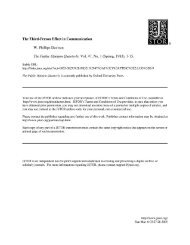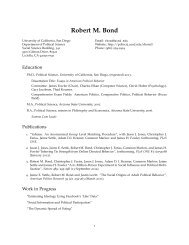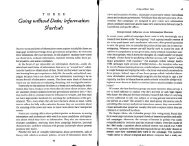Chapter 6 Why Authoritarian Parties? The Regime Party as an ...
Chapter 6 Why Authoritarian Parties? The Regime Party as an ...
Chapter 6 Why Authoritarian Parties? The Regime Party as an ...
Create successful ePaper yourself
Turn your PDF publications into a flip-book with our unique Google optimized e-Paper software.
CHAPTER 6<br />
<strong>an</strong>y party that is in the NDP’s position. This is because it would be able to<br />
provide the necessary services to the constituents.” (K<strong>as</strong>sem 1999, 81)<br />
<strong>The</strong> party’s control over a large public sector also facilitates continued electoral domi-<br />
n<strong>an</strong>ce by allowing it to condition the distribution of public funds on the m<strong>an</strong>ifestation of<br />
political loyalty at the polls. 20 When the ruling People’s Action <strong>Party</strong> in Singapore faced<br />
the risk of receiving less th<strong>an</strong> 60% of the popular vote in 1997, prime minister Goh Chok<br />
Tong exploited the government’s widespread control over public housing – <strong>as</strong> of the year<br />
2000, 86% of Singapore<strong>an</strong>s lived in public housing (Mauzy <strong>an</strong>d Milne 2002, 90) – by threat-<br />
ening to turn into “a slum” <strong>an</strong>y district that would not vote for the ruling party. <strong>The</strong> prime<br />
minister considered this strategy “the single most import<strong>an</strong>t” factor in preserving the PAP’s<br />
domin<strong>an</strong>ce at the polls. 21<br />
<strong>The</strong> modified party service constraint (6.7) also suggests that the regime c<strong>an</strong> strengthen<br />
incentives for party service in two different but related ways. First, it c<strong>an</strong> provide more<br />
attractive terms of party membership. More specifically, the former alternative implies that<br />
better outside opportunities w must be matched by a larger promotion rate p. Consistently<br />
with this prediction, one observer of Cuba notes that admission st<strong>an</strong>dards for Cuba’s Com-<br />
munist <strong>Party</strong> membership rose <strong>an</strong>d fell depending on the state of the economy: st<strong>an</strong>dards<br />
rose in the 1970s <strong>an</strong>d 1990s, when the economy is doing poorly; st<strong>an</strong>dards declined in the<br />
1980s, when the economy improved (Corbett 2002, 178). Similarly, Schnytzer <strong>an</strong>d Sustersic<br />
(1998) report that membership in the League of Communists of Yugoslavia w<strong>as</strong> positively<br />
20See e.g. Blaydes (2010) on Egypt under the National Democratic <strong>Party</strong> <strong>an</strong>d Magaloni (2006) on Mexico<br />
under the PRI.<br />
21Eventually, the PAP won 65% the popular vote <strong>an</strong>d 81 out of 83 legislative seats. See “Upgrading link<br />
swung vote in GE”, <strong>The</strong> Straits Times, 12 J<strong>an</strong>uary 1998, <strong>an</strong>d “Singapore’s Voters Get a Choice: Slums or<br />
the Ruling <strong>Party</strong>,“ <strong>The</strong> Wall Street Journal, 31 December, 1996.<br />
31











